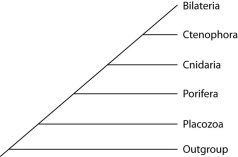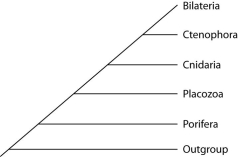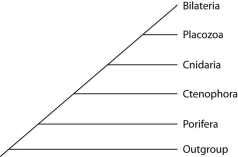Multiple Choice
Placozoan evolutionary relationships to other animals are currently unclear, and different phylogenies can be created, depending on the character used to infer relatedness. Sponges have no tissues, but about 20 cell types. Tp (Trichoplax adhaerens) produces a neuropeptide almost identical to one found in cnidarians. The genome of Tp, though the smallest of any known animal, shares many features of complex eumetazoan (even human!) genomes. The next three questions refer to the phylogenetic trees that follow.
I. 
II. 
III. 
-Cycliophorans have two types of larvae. One type of larva-the Prometheus larva-develops into a male. The male, which lacks a digestive system, attaches to the outside of a feeding stage (a female) and impregnates her digestive system, which develops into a different type of larva. What must be true of the digestive system of the feeding-stage female while she is still a virgin?
1) At least some of its cells are haploid.
2) It consists only of highly specialized cells.
3) It is the same size as the male.
A) 1 only
B) 2 only
C) 3 only
D) 1 and 3
E) 2 and 3
Correct Answer:

Verified
Correct Answer:
Verified
Q33: Some researchers claim that sponge genomes have
Q34: What does recent evidence from molecular systematics
Q35: The last common ancestor of all bilaterians
Q36: The most recently discovered phylum in the
Q37: Both animals and fungi are heterotrophic. What
Q39: What is true of the clade Ecdysozoa?<br>A)
Q40: Protostome characteristics generally include which of the
Q41: Table 32.1. Proposed Number of Hox Genes
Q42: Acoelomates are characterized by<br>A) the absence of
Q43: The larvae of some insects are merely